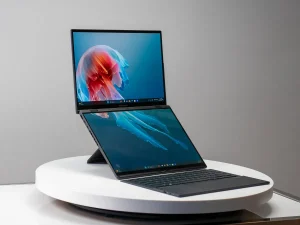When the Nintendo DS, a portable video game console with two screens, one over the other, was released, I was in the tenth grade. When I finally got my hands on the original DS a few years later, I was astounded by its design and the way the two screens improve gameplay. The most successful attempts at popularising the dual-screen concept were the Nintendo DS and its incarnations. Others have tried and failed to use dual displays on mobile devices to produce something unique. However, businesses such as Asus are currently attempting to resurrect the dual-screen idea by incorporating it into the laptop form factor. It’s undoubtedly a daring gambit. But the question still stands: what will you do with the additional screens, and will users benefit from them in any way? Having witnessed the development of dual-screen gadgets, I was eager to evaluate Asus’ ZenBook Duo.

Asus ZenBook Duo (2024) price in India (as reviewed): Rs 2,39,990
I don’t use my computer to multitask on a hundred projects at once. Like other writers, I take little pauses from my work. I like to read a lot, experiment with new apps and software, reflect, and, of course, just stare at a screen when I’m not writing and working on a tale. I am therefore more interested with how I can maximise the form factor and accomplish different things than I am with processing speed. This may sound strange, but this is who I am.
It’s interesting that “where I work” no longer matters as much as it did a few years ago. I don’t care as much about the space’s size now. Working in a tiny space or on an aeroplane seat tray pleases me. The computers and I no longer share the same priorities.
That’s the reason I usually search for a computer that is portable. There are days when I work from home and days when I work in the airport lounge. My gear must therefore be capable of operating in a variety of settings. I prefer to use as little electronics as possible, especially when I’m travelling. I therefore expect my computer to be capable of handling a wide range of tasks, and I have no problem switching out many devices for a single one.
The ZenBook Duo has a unique appearance compared to other laptops available. However, when the ZenBook Duo is closed, the differences are invisible. The ZenBook Duo transforms into a completely different notebook as soon as you open it and switch it on (more on that later).
The machine has an excellent design. It is portable and nearly as thin as an ultrabook, thanks to its quality magnesium alloy construction. It has an industrial appearance because to its grey tone and squared-off edges. The notebook is also more than capable of withstanding daily abrasion because it passed the MIL-STD-810H durability test. Numerous interfaces are supported by the chassis, including two Thunderbolt 4 connections, a headphone jack, a USB 3.2 Type-A port, and a full-size HDMI 2.1 port.
Furthermore, it fits on standard-sized train or airline seat trays with ease. When the keyboard is installed, the notebook weighs about 1.66 kg instead of 1.36 kg. It’s not as heavy as you may think—it measures 14.6 mm thin without the keyboard and 19.9 mm thin with it. I was drawn to the ZenBook Duo’s form factor and considered whether this was the ideal size for a dual-screen laptop.

Dual-screen magic
The ZenBook Duo is essentially a dual-screen clamshell touchscreen laptop with a second touchscreen on the bottom half in place of the conventional keyboard. This indicates that its design differs from that of conventional 2-in-1 convertibles and that it has nothing in common with Asus’ folding laptop, which features a screen that folds in half.
There are two 14-inch screens stacked on top of The Duo. Both of them are OLED screens with maximum resolutions of 2880 x 1800, 16:10 aspect ratios, and maximum refresh rates of 120 Hz. They provide 19.8 inches of useful screen real estate total between them. Both support the active stylus from Asus and are touch-enabled.

